Conservation Treatment: The Case of a Ninth-Century Dish from Iran
A Freer dish with molded decoration (F1957.23) was one of the first objects to be conserved thanks to a grant by the Hagop Kevorkian Fund. It belongs to a rare group of ceramic objects that were found in Samarra, the onetime capital of the Abbasid Empire (750–1258 CE) located north of Baghdad in modern-day Iraq, and in Susa, in southwestern Iran. This dish allegedly was found in Susa; other similar examples are in the collections of the Metropolitan Museum in New York, the Louvre Museum in Paris, and the Khalili collection in London (figs. 2–4).
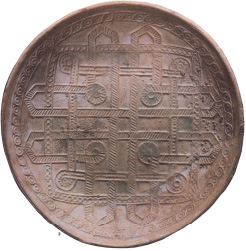
Fig. 2. Dish, Metropolitan Museum of Art, 53.110.

Fig. 3. Dish, Khalili collection of Islamic art, POT844.
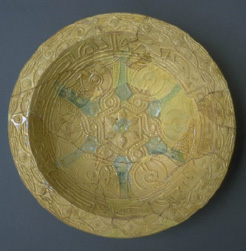
Fig. 4. Bowl, Louvre Museum, MAO S. 815.
The Freer earthenware shallow plate bears a molded decoration and is glazed in a lustrous golden color with overglaze green splashes. Its symmetrical decoration comprises interlacing bands and four palmettes that are organized around a central four-petalled rosette. This type of ware both draws on the region’s pre-Islamic artistic heritage (Roman, Sasanian, and Byzantine) and incorporates typical Abbasid motifs, such as geometric forms with highly stylized vegetal elements. Scholars have suggested that the plate’s overall shape and low relief design are based on similar examples in metal. The decoration also finds parallels in carved stucco panels and dados from buildings in Samarra and Susa.
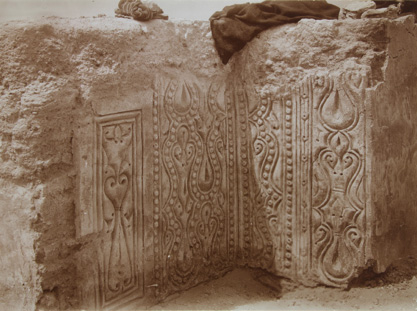
Fig. 5. Wall with stucco ornamentation, excavated in Samarra, Iraq, by Ernst Herzfeld in 1911. The Ernst Herzfeld papers, Freer Gallery of Art and Arthur M. Sackler Gallery Archives; Smithsonian Institution, Washington, DC; Gift of Ernst Herzfeld, 1946, FSA A.6 04.PF.19.136
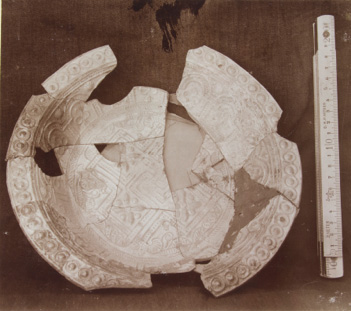
Fig. 6. A ceramic with relief decoration and probably luster glaze, very similar to F1957.23, was also excavated during this expedition. The Ernst Herzfeld papers, Freer Gallery of Art and Arthur M. Sackler Gallery Archives; Smithsonian Institution, Washington, DC; Gift of Ernst Herzfeld, 1946, FSA A.6 04.PF.20.015
The plate has a very heterogeneous glaze appearance with only a few areas still showing the original yellow color. Furthermore, only three of the eight green glaze splashes are still clearly visible; the others seem to be concealed by lighter, matte areas of deteriorated glaze.
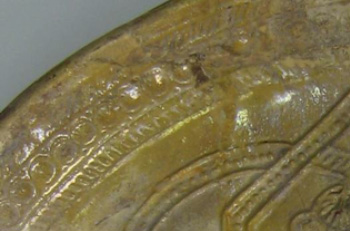
Fig. 7. Detail before treatment: relatively well-conserved area of glaze.
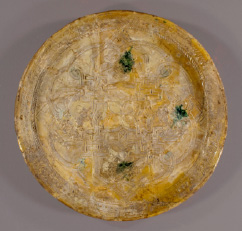
Fig. 8. F1957.23 before treatment.
The current appearance of the surface is due to a chemical alteration of the glaze. This process originates in the composition of the lead-based glaze, which can be unstable. It is triggered and/or aggravated by humidity and an acidic environment. This alteration is irreversible and at best can only be mitigated by very stable climate conditions. It can also lead to the formation of laminar surface layers and the flaking of the glaze, which would necessitate further consolidation.
The extent of the degraded glaze suggests that the Freer plate must have been buried for a considerable period. The object probably was also broken prior to or during burial and the sherds were surrounded by slightly different soil compositions, which explains the heterogeneous degradation of the glaze.
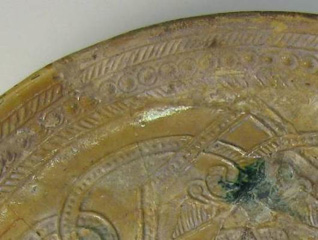
Fig. 9. Detail before treatment: heterogeneity of the glaze. The contrast is high between a sherd with relatively unaltered glaze and the upper sherd with glaze that is altered and partially covered in accretions.

Fig. 10.Detail before treatment: alteration of the glaze. This area is particularly altered and has lost its glossy surface. The green splashes are barely visible.
The plate was broken into many pieces and repaired previously. There is no record of the treatment in its conservation record, which probably indicates that the repairs were done before the plate came to the Freer. The condition of the glaze and the old repairs made it difficult to read the surface design of the original plate. We decided first to remove the paint and fills from previous restoration campaigns and lightly clean the surface of the glaze. This process revealed the glaze’s actual condition, the extent of the losses, and the plate’s highly fragmented state, consisting of seventy sherds, some of which were misaligned. The glaze was very degraded in some areas, but it did not show any sign of active deterioration or flaking.

We needed to disassemble and reassemble the sherds to improve the overall appearance of the dish. Tests showed that the old adhesive was water-soluble. As the glaze was sensitive to water, however, we used it in very small amounts, with poultices of dampened cotton wool. A few sherds that could not be disassembled were left joined. Lastly, we removed adhesive residue from the edges of the sherds, and then reassembled them.

Fig. 12. F1957.23 after disassembly of the sherds and cleaning.

Fig. 13. F1957.23 after joining the sherds.
Two approaches were possible for the filling and in-painting of the losses. The object could be shown with its losses and cracks to highlight its material condition and history; this method is more commonly used for archaeological artifacts. The second approach would consist of filling the losses and completing the pattern so that viewers could appreciate the plate without being distracted by its condition. At the same time, the in-painting could still be seen under close examination. In this case, we chose the latter option.
The American Institute for Conservation’s Code of Ethics dictates that only discernable patterns and designs on the original piece should be replicated during conservation. The fills and in-painting also must be limited to areas of loss and never cover the original surface of an object. Since the molded surface design on the Freer plate was symmetrical, the missing parts could be determined. Although we decided to reconstruct as much as possible of the original design on the obverse of the plate, a more archaeological method was adopted for the reverse, where we only filled major losses and used an easily discernable color for the in-painting. Such an approach will allow viewers to understand the original design of the plate, but also gives a clear understanding of the condition and fragility of the object to potential handlers.

Fig. 14. F1957.23 after filling the losses.

Fig. 15. Detail during treatment: the relief patterns have been modeled and sculpted to integrate the losses.

Fig. 16. F1957.23 during in-painting.

Fig. 17. Detail during in-painting.

Fig. 18. F1957.23 after treatment (obverse).

Fig. 19. F1957.23 after treatment (reverse).
Selected Bibliography
Atil, Esin; Art of the Arab World; Smithsonian Institution, Washington, DC, 1975.
Atil, Esin; Ceramics from the World of Islam; Smithsonian Institution, Washington, DC, 1973, pp. 2–3, 16–17.
Bernus-Taylor, Marthe; Arabesques et jardins de paradis; Réunion des musées nationaux, Paris, 1989.
Buys, Susan, and Oakley, Victoria; The Conservation and Restoration of Ceramics; Butterworths, London, 1993.
Grube, Ernst; Cobalt and Lustre: The First Centuries of Islamic Pottery; Nasser D. Khalili Collection of Islamic Art; Nour Foundation in association with Azimuth Editions and Oxford University Press, London, v. 9, 1994, pp. 22–23.
Jenkins, Marylin; Islamic Pottery: A Brief History; The Metropolitan Museum of Art Bulletin, vol. 40, no. 4, spring 1983, p. 6.
Keblow Bernsted, Anne-Marie; Early Islamic Pottery, Materials & Techniques; Archetype Publications, London, 2003.
Koob, Stephen; Conservation and Care of Glass Objects; Archetype Publications, London, 2006.
Newton, Roy, and Davison, Sandra; Conservation of Glass; Butterworths, London, 1989.
Pézard, Maurice; La céramique archaïque de l’Islam et ses origines; Leroux, Paris, 1920, pl. XI.
Tennent, Norman, ed., The Conservation of Glass and Ceramics. Research, Practice and Training; James & James, London, 1999.
Conservation
OverviewObjects Conservation Paper Conservation
Exhibitions Conservation
East Asian Painting Conservation Studio
More about the Department
Scientific Research
Scientific research at the Freer and Sackler Galleries is primarily focused on the physical nature of artworks from Asian cultures. More info »
Staff Publications
Publication is an integral part of our research program. Click below to view lists of published works by past and present members of the department:

